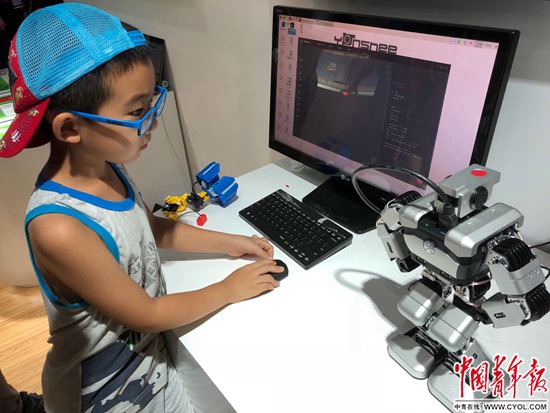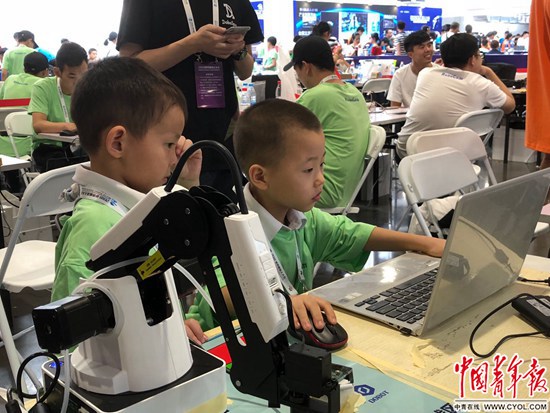

Six-year-old Bai Haoming (left) and Fu Hongzhou (right) participated in the "Intelligent Sorting Engineering Challenge" project of the Youth Robot Design Competition of the 2018 World Robotics Congress. Jess Zhang/photo
The 2018 World Robotics Congress held not long ago attracted many young people to visit and participate in the competition, and the exhibits related to children’s services naturally became the focus of everyone’s attention. In this field, many exhibitors set the function of "programming" as the key word to attract consumers, "All children in the future must be able to program".
Nowadays, "programming" is considered as one of the entry points for children to adapt to the era of artificial intelligence. Several parents interviewed randomly by reporters at the scene also said in unison: "Even if children don’t work in artificial intelligence in the future, they need to know something about robots and programming."
"Artificial intelligence starts with dolls"
In the youth robot design competition held during the conference, two small figures in the "Intelligent Sorting Engineering Challenge" area were particularly eye-catching.
The fleshy hands are as long as the mouse, and the hem of the T-shirts distributed uniformly dangles at the knees. Six-year-old Bai Haoming and Fu Hongzhou are the youngest players in this project, from Shenzhen. They have entered the threshold of programming.
"Let them do it, and don’t expect to get any rankings." Bai Haoming’s mother clung to the baffle in the field and leaned into half of her body to look at the child’s operation. She thought this was the simplest event in this competition.
In fact, this is not the case. Bai Hao-ming and Fu Hongzhou need to suck up 10 building blocks of different colors through the mechanical arm within the specified time and carry them to the area corresponding to the color. In this process, the two will cooperate with the debugging of the mechanical arm and programming to complete a series of links such as moving the mechanical arm to a designated position, accurately identifying the color, absorbing the wood blocks, and transporting the wood blocks to other designated areas.
As expected, their first attempt failed, and the green block was put in the red area. "No, no! Write the data again! " Bai Haoming’s mother is more anxious than her children.
Six-year-old Fu Hongzhou sat in front of the computer, but he was very calm. His little hand rested slowly on the mouse, and Bai Hao-ming also gathered in front of the screen. They discussed dragging the program module to reprogram, and it was soon finished. After restarting, the green building blocks were successfully transported to the corresponding green area.
In fact, when Bai Haoming was five years old, he could command the airplane model to start the propeller through computer programming. His mother was convinced that "artificial intelligence starts with dolls". Designated robot platform for this competition — — A certain type of mechanical arm is worth "20,000 to 30,000 yuan", and Bai Haoming’s mother thinks this kind of investment is very worthwhile.
Fu Hongzhou’s father also thinks that "the future must be the era of artificial intelligence". He asks his children to practice programming once or twice a week for no more than two hours at a time.
Encouraging children to learn programming is not only the choice of the above two parents. Yi Hui, a robot training coach at the scene of the Youth Robot Design Competition, told reporters that a training institution where he works has become more and more popular in the past three years: some 3-year-old children come to cultivate their structure and sense of space through spelling exercises; Learn simple programming at the age of 5 to 6, and master simple physics knowledge after preschool; After the age of 8, you can usually start to contact relatively complicated modular programming.
This time, Tian Tian, the little player he brought, began to contact the mosaic robot at the age of 3, and at the age of 5, he was able to design simple games through modular programming. Tian Tian’s father believes that the simplified programming that he is exposed to now will be helpful for children to write code programming in the future. "Although the input forms are different, the logic is the same."
However, he believes that for Xiao Tiantian, how much knowledge is acquired is second, and what is more important is the shaping of soft power. Tian Tian’s father thinks that the child’s patience has been "greatly improved" and "he can analyze the reasons himself in the face of failure".
What kind of education scheme is suitable for you?
In fact, not only in the competition, but also in the Expo and product exhibition area of the World Robotics Congress, "programming" is also the key word in the hearts of parents and children who come to visit.
Mr. Liu from Beijing and his 6-year-old son Yangyang stopped in front of a programming robot for just over ten minutes, and Yangyang learned how to make the robot parrot dance by using action memory programming.
Mr. Liu introduced that Yangyang was able to put together hundreds of models at the age of four, so this time he bought a programming robot worth 1299 yuan for his son without hesitation. I believe programming is not difficult for his son.
"Artificial intelligence will be very popular in the future, and he should be exposed to the development trend of society." Mr. Liu said.
Judging from the popularity of on-site programming robots, Mr. Liu seems to have spoken the voice of most parents. Exhibitors don’t need to elaborate on the significance of programming to children’s development. As long as they put out their own products, they will be quickly surrounded by a wave of teenagers and parents.
The reporter noted that in order to meet the needs of children, parents, schools and training institutions, many related enterprises are actively developing educational programs for "cultivating aborigines in the era of artificial intelligence", and the concepts and characteristics of each supplier are different.
Taking a certain type of programming robot selected by Yangyang children as an example, simple programming learning can be carried out after the robot components and motors are inserted. The programming methods include "action memory programming" and "graphical programming".
According to reports, teaching material packages including such programming robots have landed in several children’s palaces and primary schools around the country. Guo Zuyun, an information technology teacher at the experimental primary school in Kunming Economic and Technological Development Zone, is one of the users. He introduced that in order to be in line with the era of artificial intelligence, the school built a new function room and introduced a number of engineering intelligence teaching materials. "There are more than 900 people in the school, and more than 200 people have chosen my class. However, due to limited conditions, we only recruited 35 people. "
In the mobile game My World: Education Edition, which is popular among teenagers, children can cultivate computational thinking through visual programming. It is understood that teachers in more than 100 countries around the world are promoting classroom innovation and collaboration through this game.
People are exploring various possibilities of artificial intelligence education. Material packages, laboratories, interdisciplinary educational research and practice platforms, mobile games or public welfare activities, and various educational programs are dazzling. At present, what remains unchanged is that "programming" has become the intersection of various schemes.
"The traditional concept is that learning programming is to be a code farmer in the future, but it is not. The future world will be a digital world, and writing code may be as natural and necessary as writing articles and learning languages today. " An industry insider in the field of artificial intelligence education told reporters. (China Youth Daily Zhongqing Online Reporter Jess Zhang)
关于作者